FIAT DUCATO BASE CAMPER 2015 Owner handbook (in English)
Manufacturer: FIAT, Model Year: 2015, Model line: DUCATO BASE CAMPER, Model: FIAT DUCATO BASE CAMPER 2015Pages: 367, PDF Size: 19.73 MB
Page 61 of 367
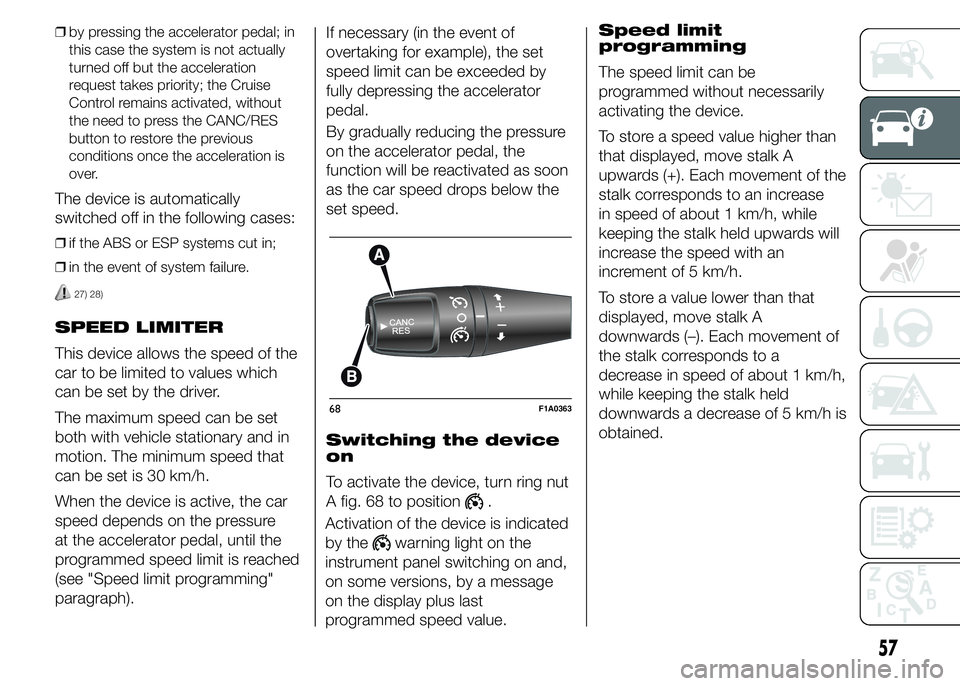
❒by pressing the accelerator pedal; in
this case the system is not actually
turned off but the acceleration
request takes priority; the Cruise
Control remains activated, without
the need to press the CANC/RES
button to restore the previous
conditions once the acceleration is
over.
The device is automatically
switched off in the following cases:
❒if the ABS or ESP systems cut in;
❒in the event of system failure.
27) 28)
SPEED LIMITER
This device allows the speed of the
car to be limited to values which
can be set by the driver.
The maximum speed can be set
both with vehicle stationary and in
motion. The minimum speed that
can be set is 30 km/h.
When the device is active, the car
speed depends on the pressure
at the accelerator pedal, until the
programmed speed limit is reached
(see "Speed limit programming"
paragraph).If necessary (in the event of
overtaking for example), the set
speed limit can be exceeded by
fully depressing the accelerator
pedal.
By gradually reducing the pressure
on the accelerator pedal, the
function will be reactivated as soon
as the car speed drops below the
set speed.
Switching the device
on
To activate the device, turn ring nut
A fig. 68 to position
.
Activation of the device is indicated
by the
warning light on the
instrument panel switching on and,
on some versions, by a message
on the display plus last
programmed speed value.Speed limit
programming
The speed limit can be
programmed without necessarily
activating the device.
To store a speed value higher than
that displayed, move stalk A
upwards (+). Each movement of the
stalk corresponds to an increase
in speed of about 1 km/h, while
keeping the stalk held upwards will
increase the speed with an
increment of 5 km/h.
To store a value lower than that
displayed, move stalk A
downwards (–). Each movement of
the stalk corresponds to a
decrease in speed of about 1 km/h,
while keeping the stalk held
downwards a decrease of 5 km/h is
obtained.
68F1A0363
57
Page 62 of 367
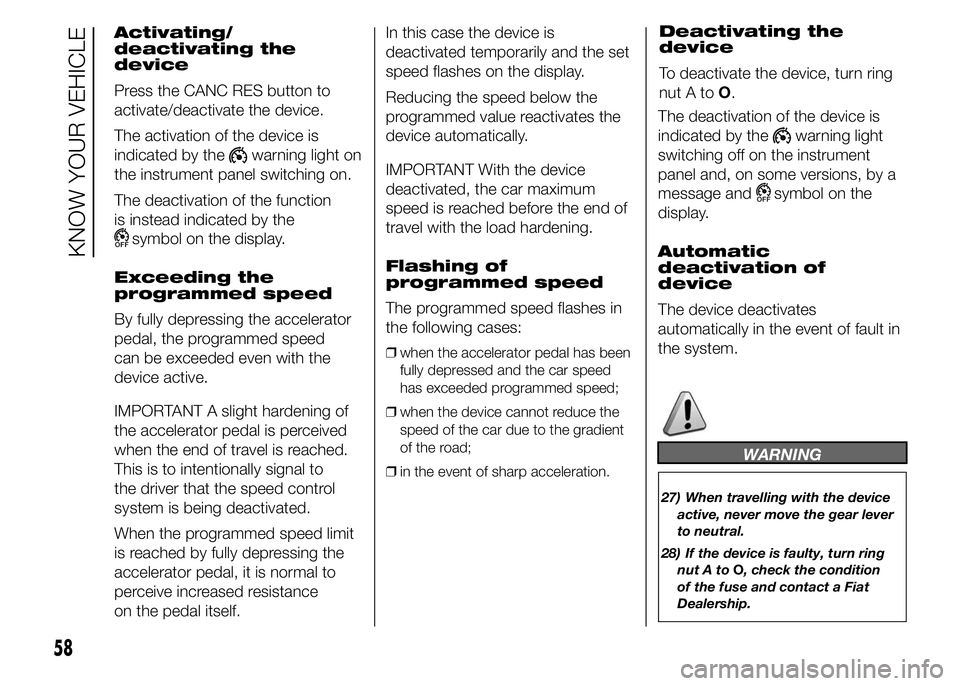
Activating/
deactivating the
device
Press the CANC RES button to
activate/deactivate the device.
The activation of the device is
indicated by the
warning light on
the instrument panel switching on.
The deactivation of the function
is instead indicated by the
symbol on the display.
Exceeding the
programmed speed
By fully depressing the accelerator
pedal, the programmed speed
can be exceeded even with the
device active.
IMPORTANT A slight hardening of
the accelerator pedal is perceived
when the end of travel is reached.
This is to intentionally signal to
the driver that the speed control
system is being deactivated.
When the programmed speed limit
is reached by fully depressing the
accelerator pedal, it is normal to
perceive increased resistance
on the pedal itself.In this case the device is
deactivated temporarily and the set
speed flashes on the display.
Reducing the speed below the
programmed value reactivates the
device automatically.
IMPORTANT With the device
deactivated, the car maximum
speed is reached before the end of
travel with the load hardening.
Flashing of
programmed speed
The programmed speed flashes in
the following cases:
❒when the accelerator pedal has been
fully depressed and the car speed
has exceeded programmed speed;
❒when the device cannot reduce the
speed of the car due to the gradient
of the road;
❒in the event of sharp acceleration.
Deactivating the
device
To deactivate the device, turn ring
nutAtoO.
The deactivation of the device is
indicated by the
warning light
switching off on the instrument
panel and, on some versions, by a
message and
symbol on the
display.
Automatic
deactivation of
device
The device deactivates
automatically in the event of fault in
the system.
WARNING
27) When travelling with the device
active, never move the gear lever
to neutral.
28) If the device is faulty, turn ring
nutAtoO, check the condition
of the fuse and contact a Fiat
Dealership.
58
KNOW YOUR VEHICLE
Page 63 of 367
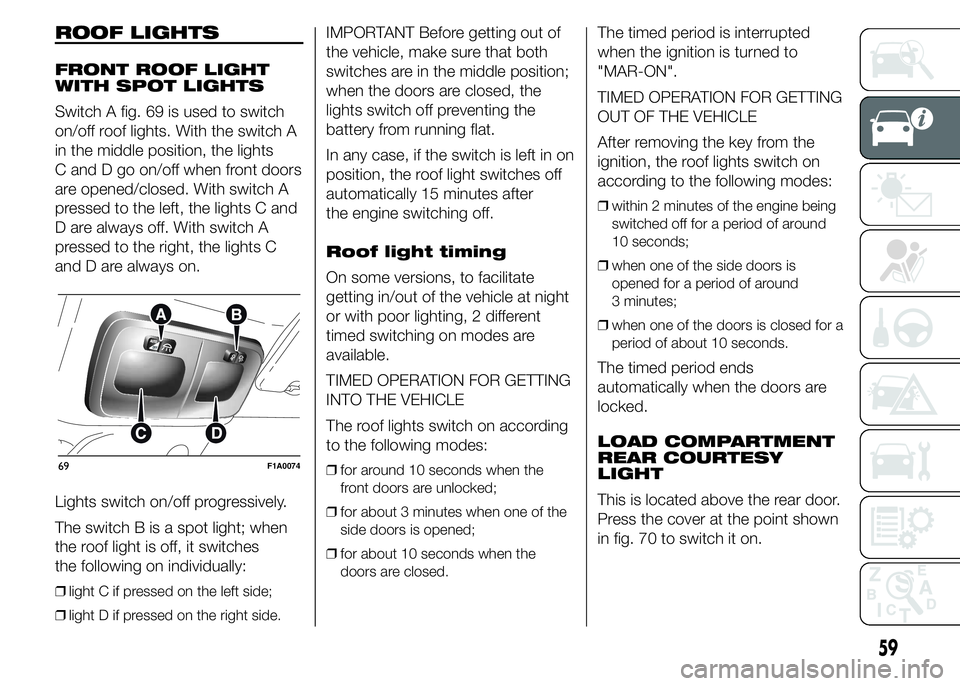
ROOF LIGHTS
FRONT ROOF LIGHT
WITH SPOT LIGHTS
Switch A fig. 69 is used to switch
on/off roof lights. With the switch A
in the middle position, the lights
C and D go on/off when front doors
are opened/closed. With switch A
pressed to the left, the lights C and
D are always off. With switch A
pressed to the right, the lights C
and D are always on.
Lights switch on/off progressively.
The switch B is a spot light; when
the roof light is off, it switches
the following on individually:
❒light C if pressed on the left side;
❒light D if pressed on the right side.
IMPORTANT Before getting out of
the vehicle, make sure that both
switches are in the middle position;
when the doors are closed, the
lights switch off preventing the
battery from running flat.
In any case, if the switch is left in on
position, the roof light switches off
automatically 15 minutes after
the engine switching off.
Roof light timing
On some versions, to facilitate
getting in/out of the vehicle at night
or with poor lighting, 2 different
timed switching on modes are
available.
TIMED OPERATION FOR GETTING
INTO THE VEHICLE
The roof lights switch on according
to the following modes:
❒for around 10 seconds when the
front doors are unlocked;
❒for about 3 minutes when one of the
side doors is opened;
❒for about 10 seconds when the
doors are closed.
The timed period is interrupted
when the ignition is turned to
"MAR-ON".
TIMED OPERATION FOR GETTING
OUT OF THE VEHICLE
After removing the key from the
ignition, the roof lights switch on
according to the following modes:
❒within 2 minutes of the engine being
switched off for a period of around
10 seconds;
❒when one of the side doors is
opened for a period of around
3 minutes;
❒when one of the doors is closed for a
period of about 10 seconds.
The timed period ends
automatically when the doors are
locked.
LOAD COMPARTMENT
REAR COURTESY
LIGHT
This is located above the rear door.
Press the cover at the point shown
in fig. 70 to switch it on.
69F1A0074
59
Page 64 of 367
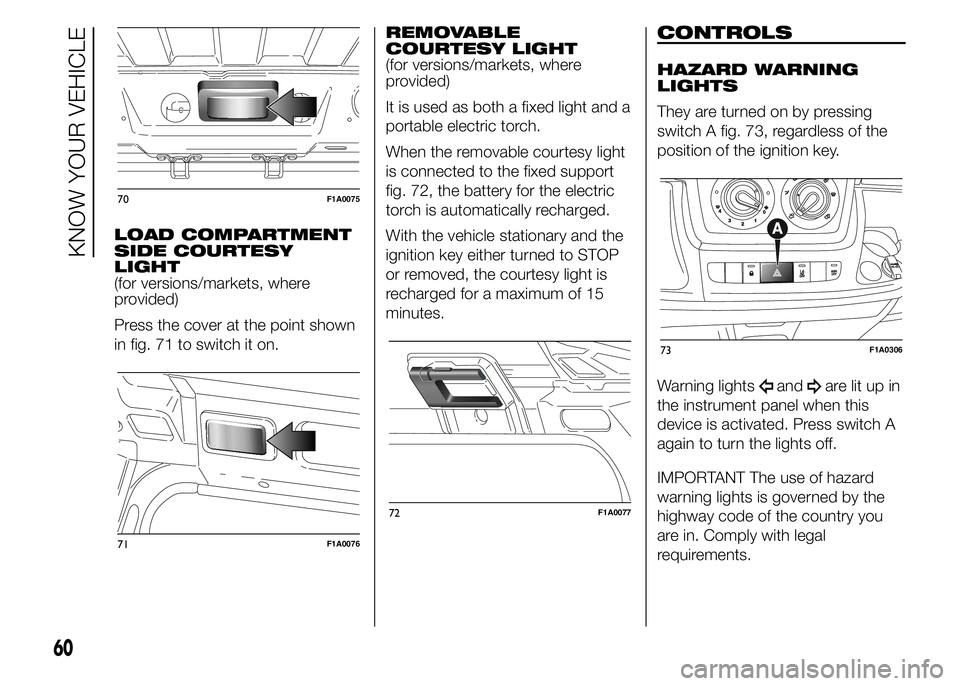
LOAD COMPARTMENT
SIDE COURTESY
LIGHT
(for versions/markets, where
provided)
Press the cover at the point shown
in fig. 71 to switch it on.REMOVABLE
COURTESY LIGHT
(for versions/markets, where
provided)
It is used as both a fixed light and a
portable electric torch.
When the removable courtesy light
is connected to the fixed support
fig. 72, the battery for the electric
torch is automatically recharged.
With the vehicle stationary and the
ignition key either turned to STOP
or removed, the courtesy light is
recharged for a maximum of 15
minutes.
CONTROLS
HAZARD WARNING
LIGHTS
They are turned on by pressing
switch A fig. 73, regardless of the
position of the ignition key.
Warning lights
andare lit up in
the instrument panel when this
device is activated. Press switch A
again to turn the lights off.
IMPORTANT The use of hazard
warning lights is governed by the
highway code of the country you
are in. Comply with legal
requirements.
70F1A0075
71F1A0076
72F1A0077
73F1A0306
60
KNOW YOUR VEHICLE
Page 65 of 367
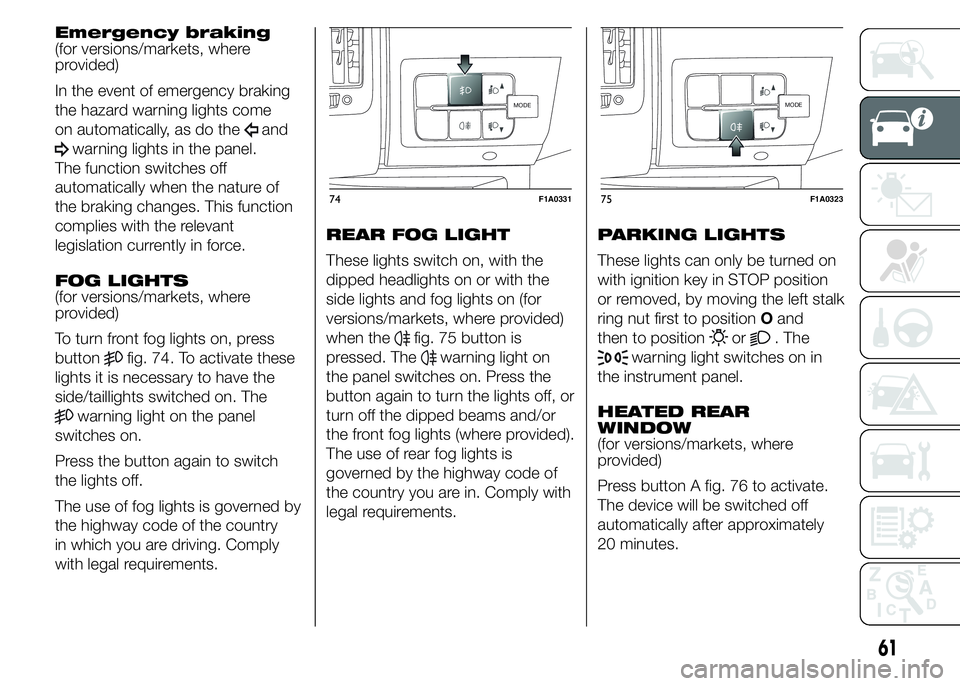
Emergency braking
(for versions/markets, where
provided)
In the event of emergency braking
the hazard warning lights come
on automatically, as do the
and
warning lights in the panel.
The function switches off
automatically when the nature of
the braking changes. This function
complies with the relevant
legislation currently in force.
FOG LIGHTS
(for versions/markets, where
provided)
To turn front fog lights on, press
button
fig. 74. To activate these
lights it is necessary to have the
side/taillights switched on. The
warning light on the panel
switches on.
Press the button again to switch
the lights off.
The use of fog lights is governed by
the highway code of the country
in which you are driving. Comply
with legal requirements.REAR FOG LIGHT
These lights switch on, with the
dipped headlights on or with the
side lights and fog lights on (for
versions/markets, where provided)
when the
fig. 75 button is
pressed. The
warning light on
the panel switches on. Press the
button again to turn the lights off, or
turn off the dipped beams and/or
the front fog lights (where provided).
The use of rear fog lights is
governed by the highway code of
the country you are in. Comply with
legal requirements.PARKING LIGHTS
These lights can only be turned on
with ignition key in STOP position
or removed, by moving the left stalk
ring nut first to positionOand
then to position
or. The
warning light switches on in
the instrument panel.
HEATED REAR
WINDOW
(for versions/markets, where
provided)
Press button A fig. 76 to activate.
The device will be switched off
automatically after approximately
20 minutes.
MODE
74F1A0331
MODE
75F1A0323
61
Page 66 of 367
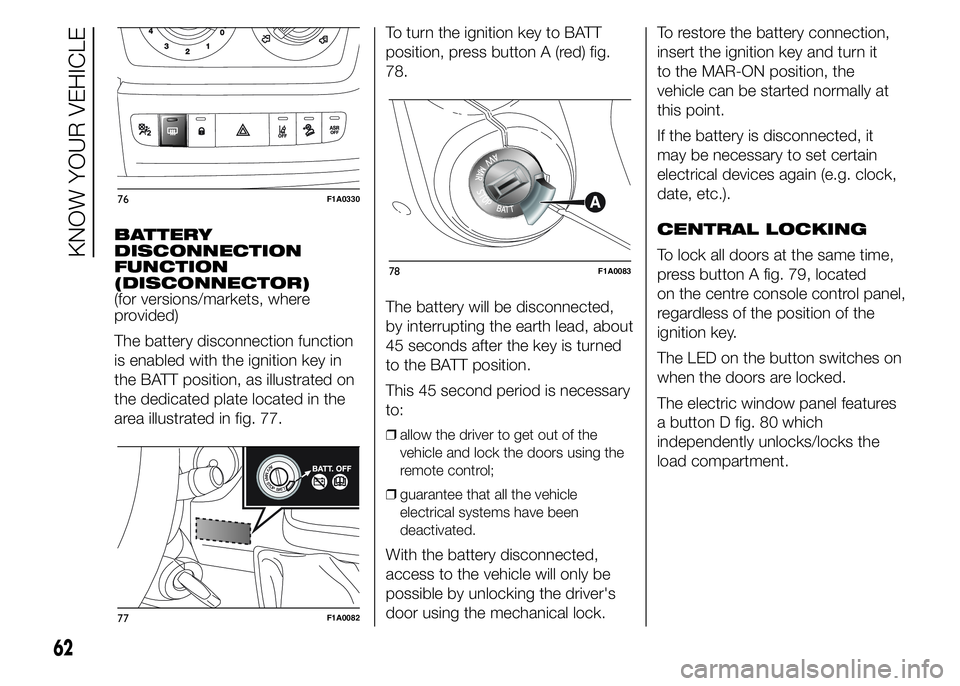
BATTERY
DISCONNECTION
FUNCTION
(DISCONNECTOR)
(for versions/markets, where
provided)
The battery disconnection function
is enabled with the ignition key in
the BATT position, as illustrated on
the dedicated plate located in the
area illustrated in fig. 77.To turn the ignition key to BATT
position, press button A (red) fig.
78.
The battery will be disconnected,
by interrupting the earth lead, about
45 seconds after the key is turned
to the BATT position.
This 45 second period is necessary
to:
❒allow the driver to get out of the
vehicle and lock the doors using the
remote control;
❒guarantee that all the vehicle
electrical systems have been
deactivated.
With the battery disconnected,
access to the vehicle will only be
possible by unlocking the driver's
door using the mechanical lock.To restore the battery connection,
insert the ignition key and turn it
to the MAR-ON position, the
vehicle can be started normally at
this point.
If the battery is disconnected, it
may be necessary to set certain
electrical devices again (e.g. clock,
date, etc.).
CENTRAL LOCKING
To lock all doors at the same time,
press button A fig. 79, located
on the centre console control panel,
regardless of the position of the
ignition key.
The LED on the button switches on
when the doors are locked.
The electric window panel features
a button D fig. 80 which
independently unlocks/locks the
load compartment.
76F1A0330
77F1A0082
78F1A0083
62
KNOW YOUR VEHICLE
Page 67 of 367
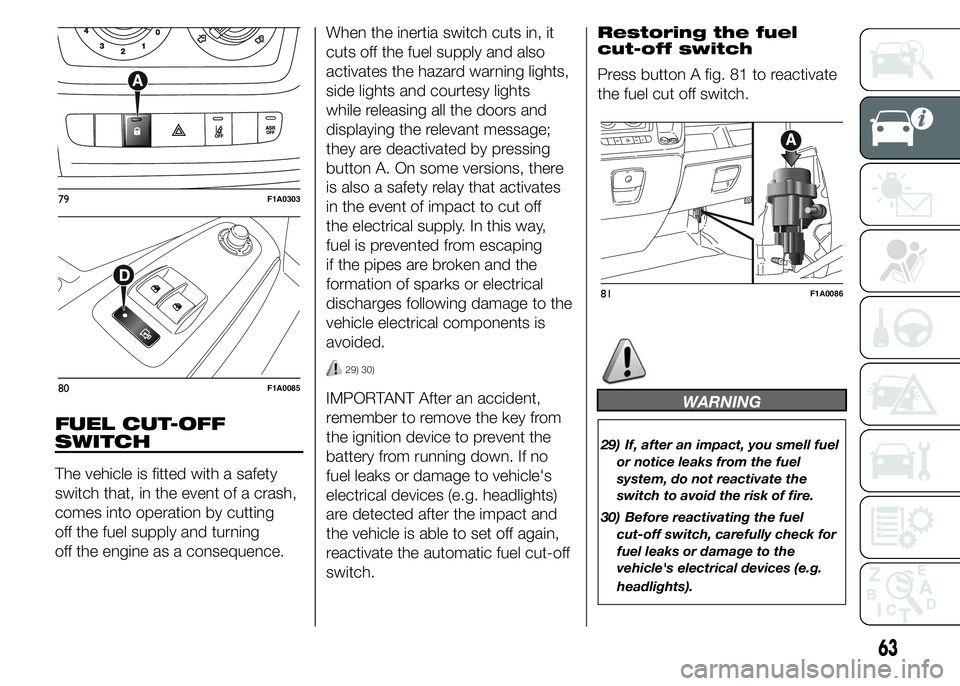
FUEL CUT-OFF
SWITCH
The vehicle is fitted with a safety
switch that, in the event of a crash,
comes into operation by cutting
off the fuel supply and turning
off the engine as a consequence.When the inertia switch cuts in, it
cuts off the fuel supply and also
activates the hazard warning lights,
side lights and courtesy lights
while releasing all the doors and
displaying the relevant message;
they are deactivated by pressing
button A. On some versions, there
is also a safety relay that activates
in the event of impact to cut off
the electrical supply. In this way,
fuel is prevented from escaping
if the pipes are broken and the
formation of sparks or electrical
discharges following damage to the
vehicle electrical components is
avoided.
29) 30)
IMPORTANT After an accident,
remember to remove the key from
the ignition device to prevent the
battery from running down. If no
fuel leaks or damage to vehicle's
electrical devices (e.g. headlights)
are detected after the impact and
the vehicle is able to set off again,
reactivate the automatic fuel cut-off
switch.Restoring the fuel
cut-off switch
Press button A fig. 81 to reactivate
the fuel cut off switch.WARNING
29) If, after an impact, you smell fuel
or notice leaks from the fuel
system, do not reactivate the
switch to avoid the risk of fire.
30) Before reactivating the fuel
cut-off switch, carefully check for
fuel leaks or damage to the
vehicle's electrical devices (e.g.
headlights).
79F1A0303
80F1A0085
81F1A0086
63
Page 68 of 367
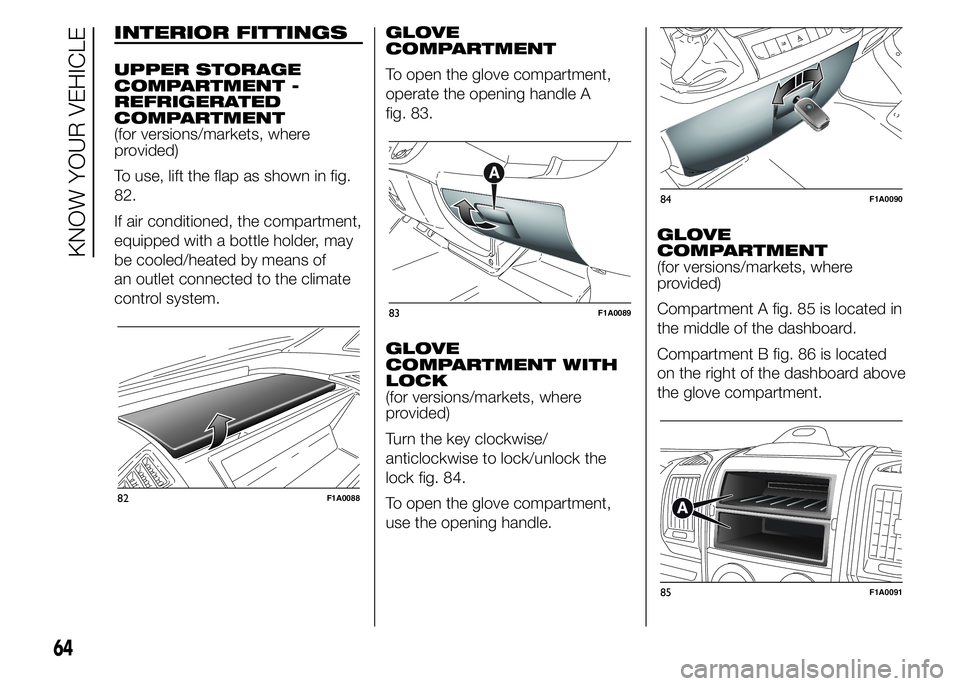
INTERIOR FITTINGS
UPPER STORAGE
COMPARTMENT -
REFRIGERATED
COMPARTMENT
(for versions/markets, where
provided)
To use, lift the flap as shown in fig.
82.
If air conditioned, the compartment,
equipped with a bottle holder, may
be cooled/heated by means of
an outlet connected to the climate
control system.GLOVE
COMPARTMENT
To open the glove compartment,
operate the opening handle A
fig. 83.
GLOVE
COMPARTMENT WITH
LOCK
(for versions/markets, where
provided)
Turn the key clockwise/
anticlockwise to lock/unlock the
lock fig. 84.
To open the glove compartment,
use the opening handle.GLOVE
COMPARTMENT
(for versions/markets, where
provided)
Compartment A fig. 85 is located in
the middle of the dashboard.
Compartment B fig. 86 is located
on the right of the dashboard above
the glove compartment.
82F1A0088
83F1A0089
84F1A0090
85F1A0091
64
KNOW YOUR VEHICLE
Page 69 of 367
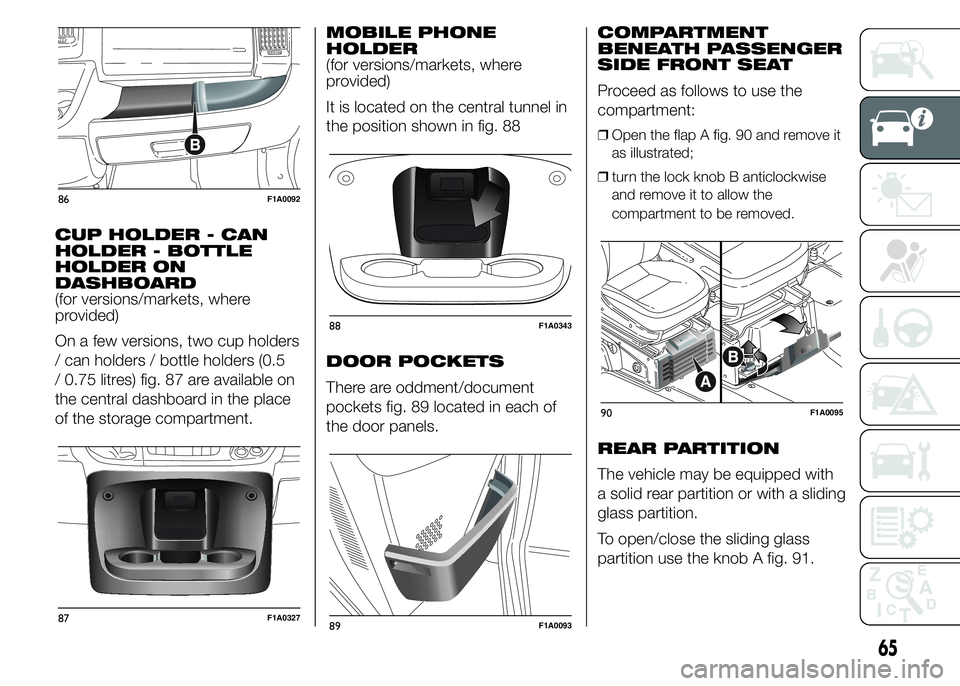
CUP HOLDER - CAN
HOLDER - BOTTLE
HOLDER ON
DASHBOARD
(for versions/markets, where
provided)
On a few versions, two cup holders
/ can holders / bottle holders (0.5
/ 0.75 litres) fig. 87 are available on
the central dashboard in the place
of the storage compartment.MOBILE PHONE
HOLDER
(for versions/markets, where
provided)
It is located on the central tunnel in
the position shown in fig. 88
DOOR POCKETS
There are oddment/document
pockets fig. 89 located in each of
the door panels.COMPARTMENT
BENEATH PASSENGER
SIDE FRONT SEAT
Proceed as follows to use the
compartment:
❒Open the flap A fig. 90 and remove it
as illustrated;
❒turn the lock knob B anticlockwise
and remove it to allow the
compartment to be removed.
REAR PARTITION
The vehicle may be equipped with
a solid rear partition or with a sliding
glass partition.
To open/close the sliding glass
partition use the knob A fig. 91.
86F1A0092
87F1A0327
88F1A0343
89F1A0093
90F1A0095
65
Page 70 of 367
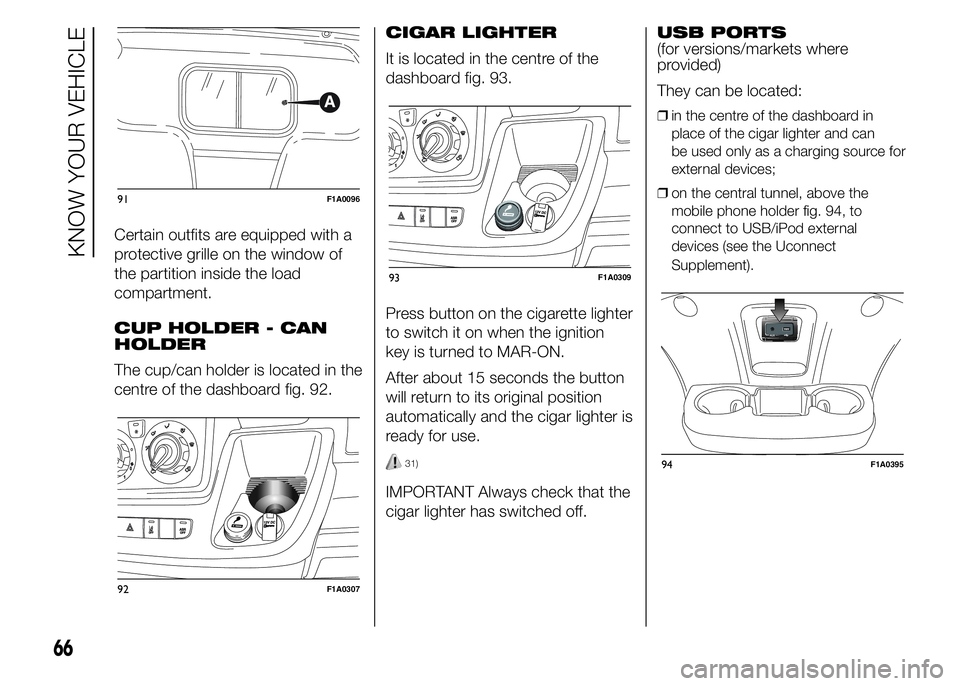
Certain outfits are equipped with a
protective grille on the window of
the partition inside the load
compartment.
CUP HOLDER - CAN
HOLDER
The cup/can holder is located in the
centre of the dashboard fig. 92.CIGAR LIGHTER
It is located in the centre of the
dashboard fig. 93.
Press button on the cigarette lighter
to switch it on when the ignition
key is turned to MAR-ON.
After about 15 seconds the button
will return to its original position
automatically and the cigar lighter is
ready for use.
31)
IMPORTANT Always check that the
cigar lighter has switched off.USB PORTS
(for versions/markets where
provided)
They can be located:
❒in the centre of the dashboard in
place of the cigar lighter and can
be used only as a charging source for
external devices;
❒on the central tunnel, above the
mobile phone holder fig. 94, to
connect to USB/iPod external
devices (see the Uconnect
Supplement).
91F1A0096
92F1A0307
93F1A0309
66
KNOW YOUR VEHICLE
94F1A0395